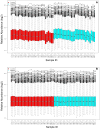Perturbations in the lipid profile of individuals with newly diagnosed type 1 diabetes mellitus: lipidomics analysis of a Diabetes Antibody Standardization Program sample subset
- PMID: 20519132
- PMCID: PMC2919299
- DOI: 10.1016/j.clinbiochem.2010.04.075
Perturbations in the lipid profile of individuals with newly diagnosed type 1 diabetes mellitus: lipidomics analysis of a Diabetes Antibody Standardization Program sample subset
Abstract
Objectives: To characterize the lipid profile of individuals with newly diagnosed type 1 diabetes mellitus using LC-MS-based lipidomics and the accurate mass and time (AMT) tag approach.
Design and methods: Lipids were extracted from plasma and sera of 10 subjects from the Diabetes Antibody Standardization Program (years 2000-2005) and 10 non-diabetic subjects and analyzed by capillary liquid chromatography coupled with a hybrid ion-trap-Fourier transform ion cyclotron resonance mass spectrometer. Lipids were identified and quantified using the AMT tag approach.
Results: Five hundred fifty-nine lipid features differentiated (q<0.05) diabetic from healthy individuals in a partial least-squares analysis, characterizing individuals with recently diagnosed type 1 diabetes mellitus.
Conclusions: A lipid profile associated with newly diagnosed type 1 diabetes may aid in further characterization of biochemical pathways involved in lipid regulation or mobilization.
2010 The Canadian Society of Clinical Chemists. All rights reserved.
Figures





Similar articles
-
The Lipidomic Profile Is Associated with the Dietary Pattern in Subjects with and without Diabetes Mellitus from a Mediterranean Area.Nutrients. 2024 Jun 8;16(12):1805. doi: 10.3390/nu16121805. Nutrients. 2024. PMID: 38931159 Free PMC article.
-
Accurate mass and retention time library of serum lipids for type 1 diabetes research.Anal Bioanal Chem. 2019 Sep;411(23):5937-5949. doi: 10.1007/s00216-019-01997-7. Epub 2019 Jul 6. Anal Bioanal Chem. 2019. PMID: 31280478 Free PMC article.
-
Characterization of plasma lipidomics in adolescent subjects with increased risk for type 1 diabetes in the DiPiS cohort.Metabolomics. 2020 Oct 8;16(10):109. doi: 10.1007/s11306-020-01730-x. Metabolomics. 2020. PMID: 33033923 Free PMC article.
-
Screening of synthetic PDE-5 inhibitors and their analogues as adulterants: analytical techniques and challenges.J Pharm Biomed Anal. 2014 Jan;87:176-90. doi: 10.1016/j.jpba.2013.04.037. Epub 2013 May 6. J Pharm Biomed Anal. 2014. PMID: 23721687 Review.
-
Enabling High Structural Specificity to Lipidomics by Coupling Photochemical Derivatization with Tandem Mass Spectrometry.Acc Chem Res. 2021 Oct 19;54(20):3873-3882. doi: 10.1021/acs.accounts.1c00419. Epub 2021 Sep 27. Acc Chem Res. 2021. PMID: 34570464 Review.
Cited by
-
The Lipidomic Profile Is Associated with the Dietary Pattern in Subjects with and without Diabetes Mellitus from a Mediterranean Area.Nutrients. 2024 Jun 8;16(12):1805. doi: 10.3390/nu16121805. Nutrients. 2024. PMID: 38931159 Free PMC article.
-
GALLIC ACID IMPROVES OXIDATIVE STRESS AND INFLAMMATION THROUGH REGULATING MICRORNAS EXPRESSIONS IN THE BLOOD OF DIABETIC RATS.Acta Endocrinol (Buchar). 2019 Apr-Jun;15(2):187-194. doi: 10.4183/aeb.2019.187. Acta Endocrinol (Buchar). 2019. PMID: 31508175 Free PMC article.
-
Accurate mass and retention time library of serum lipids for type 1 diabetes research.Anal Bioanal Chem. 2019 Sep;411(23):5937-5949. doi: 10.1007/s00216-019-01997-7. Epub 2019 Jul 6. Anal Bioanal Chem. 2019. PMID: 31280478 Free PMC article.
-
Fenofibrate promotes PPARα-targeted recovery of the intestinal epithelial barrier at the host-microbe interface in dogs with diabetes mellitus.Sci Rep. 2021 Jun 29;11(1):13454. doi: 10.1038/s41598-021-92966-7. Sci Rep. 2021. PMID: 34188162 Free PMC article.
-
Dynamics of Plasma Lipidome in Progression to Islet Autoimmunity and Type 1 Diabetes - Type 1 Diabetes Prediction and Prevention Study (DIPP).Sci Rep. 2018 Jul 13;8(1):10635. doi: 10.1038/s41598-018-28907-8. Sci Rep. 2018. PMID: 30006587 Free PMC article.
References
-
- Gepts W. Pathologic anatomy of the pancreas in juvenile diabetes mellitus. Diabetes. 1965;14:619–633. - PubMed
-
- Bingley PJ, Bonifacio E, Williams AJ, Genovese S, Bottazzo GF, Gale EA. Prediction of IDDM in the general population: strategies based on combinations of autoantibody markers. Diabetes. 1997;46:1701–1710. - PubMed
-
- Seissler J, Hatziagelaki E, Scherbaum WA. Modern concepts for the prediction of type 1 diabetes. Exp Clin Endocrinol Diabetes. 2001;109 (Suppl 2):S304–316. - PubMed
-
- LaGasse JM, Brantley MS, Leech NJ, et al. Successful prospective prediction of type 1 diabetes in schoolchildren through multiple defined autoantibodies: an 8-year follow-up of the Washington State Diabetes Prediction Study. Diabetes Care. 2002;25:505–511. - PubMed
Publication types
MeSH terms
Substances
Grants and funding
LinkOut - more resources
Full Text Sources
Other Literature Sources
Medical

